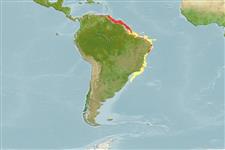Elasmobranchii (Haie und Rochen) (sharks and rays) >
Carcharhiniformes (Ground sharks) >
Triakidae (Houndsharks) > Triakinae
Etymology: Mustelus: Latin for weasel, an ancient name for sharks, possibly referring to the pointed snouts, swift movements and/or rapacious feeding behavior of smaller predatory sharks [strictly not tautonymous with Squalus mustelus Linnaeus 1758 since type was designated by the ICZN]. (See ETYFish); higmani: In honor of American fisheries biologist James B. Higman (1922-2009), U.S. Fish and Wildlife Service, for his “initial interest in the species and his care in the preparation of excellent notes on its natural history” while serving as an observer on the vessel from which it was collected. (See ETYFish).
Environment: milieu / climate zone / depth range / distribution range
Ökologie
seewasser; brackwasser demersal; tiefenbereich 1 - 900 m (Ref. 55584). Deep-water; 11°N - 36°S
Western Atlantic: northern coast of Venezuela southward to Brazil.
Length at first maturity / Size / Gewicht / Alter
Maturity: Lm ?, range 48 - ? cm
Max length : 77.4 cm TL Männchen/unbestimmt; (Ref. 126011); common length : 55.0 cm TL Männchen/unbestimmt; (Ref. 5217); max. veröff. Gewicht: 1.6 kg (Ref. 126011)
Found on the continental shelf on muddy, sandy and calcareous bottoms. Also occurs in shallow brackish water. Feeds mainly on crustaceans and occasionally on bony fishes, squids, and coelenterates. Viviparous (with yolk-sac placenta), with 1 to 7 young per litter. Catches consisting of mainly adults of one sex suggest at least partial sexual segregation. Utilized for human consumption.
Viviparous, with a yolk-sac placenta (Ref. 244).
Compagno, L.J.V., 1984. FAO Species Catalogue. Vol. 4. Sharks of the world. An annotated and illustrated catalogue of shark species known to date. Part 2 - Carcharhiniformes. FAO Fish. Synop. 125(4/2):251-655. Rome: FAO. (Ref. 244)
IUCN Rote Liste Status (Ref. 130435)
Bedrohung für Menschen
Harmless
Nutzung durch Menschen
Fischereien: kommerziell
Mehr Information
ReferenzenAquakulturAquakultur ProfilZuchtlinienGenetikElectrophoresesVererbbarkeitKrankheitenVerarbeitungNutrientsMass conversion
PartnerBilderStamps, Coins Misc.LauteCiguateraGeschwindigkeitSchwimmstilKiemenoberflächeOtolithsGehirngrößeSehfähigkeit
Tools
Zusatzinformationen
Download XML
Internet Quellen
Estimates based on models
Preferred temperature (Ref.
123201): 9.6 - 24.1, mean 15.4 °C (based on 49 cells).
Phylogenetic diversity index (Ref.
82804): PD
50 = 0.5000 [Uniqueness, from 0.5 = low to 2.0 = high].
Bayesian length-weight: a=0.00155 (0.00102 - 0.00235), b=3.15 (3.03 - 3.27), in cm total length, based on LWR estimates for this species & Genus-body shape (Ref.
93245).
Trophic level (Ref.
69278): 3.6 ±0.3 se; based on diet studies.
Widerstandsfähigkeit (Ref.
120179): sehr niedrig, Verdopplung der Population dauert mehr als 14 Jahre. (Fec=1).
Fishing Vulnerability (Ref.
59153): Moderate to high vulnerability (51 of 100).
